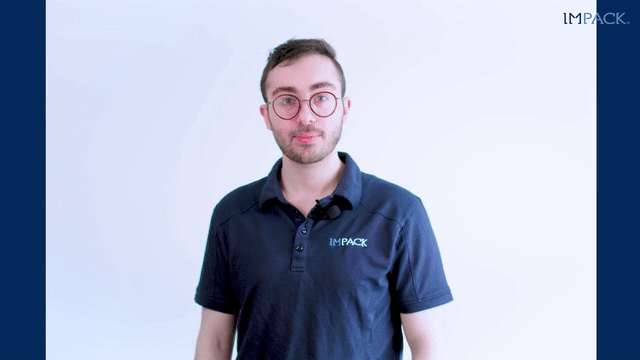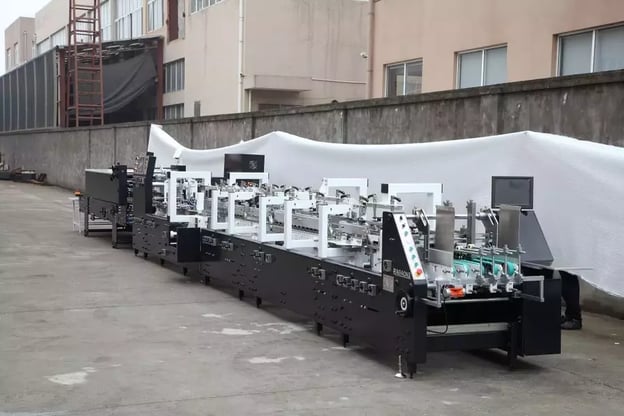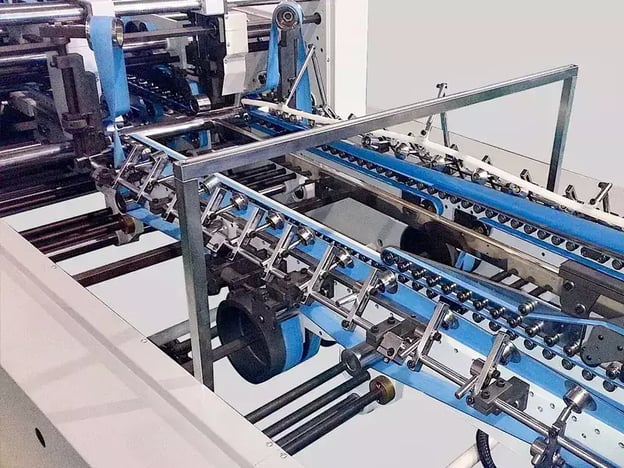What Is a Folder-Gluer Machine? (Definition, Cost, Options)
If you’re on the market for a new folder-gluer, you’re probably here for 1 or more of the following reasons:
9 min read
 Stefan Badertscher
:
December 19, 2020
Stefan Badertscher
:
December 19, 2020
![How to Maximize Your Folder-Gluer Productivity [+ FULL VIDEO]](https://impack.ca/hubfs/X21-006.png)
✋ Attention packaging producers ✋!
There is a very high chance that you were just thinking of getting a new folder-gluer, but a “hunch” made you think twice and search google for answers before you rang your folder-gluer manufacturer.
And you happened to land on this article.
👉 Are you here because of one or more of the 4 reasons below?
No matter which of those reason(s) you fit within, you can probably agree with me that you all share one thing in common: You want to produce more with your folder-gluer, but you’ve been bottlenecked at the gluer, packer or feeder.
It can be a very frustrating reality.
The good news is that despite being a letdown, this is easily solvable.
With the demand for unconventional boxes rapidly growing, carton box manufacturers are forced to meet the ever-evolving needs of the market.
This means being capable of adapting easily — and fast.
As flexibility has become the forefront priority for carton box manufacturers, we here at IMPACK have dedicated ourselves to providing solutions around folder-gluer lines for the last 20 years.
In this VIDEO + ARTICLE, we will dive deep into how you could maximize the productivity of your folder-gluer.

Note: We completely understand that not everyone can or is ready to invest in folder-gluer packaging equipment and so this article will show you how you can increase the productivity of your folder-gluer with investing and without investing.

👉 Quick question: Have you prepared yourself to adapt and quickly respond to the market's complex needs 🤔?
If you answered “No,” then what do you think is the solution to respond to those needs?
Did you say “a new folder-gluer?”
A lot of our clients believe that buying a new folder-gluer to increase the efficiency of their production is the solution, and if you thought that too, you are not alone.
In some cases, buying a new folder-gluer is a viable solution and we will explore those cases in this section.
The first step to answering this question is to identify why the capacity of your current folder-gluer is limited.
In other words, where is the bottleneck taking place?
Is it at the gluing, packing or feeding stage(s)?
Once identified, collect data on your production and work methods.
Analyzing this data will give you an accurate picture of where you are today, where you want to go and how you will get there.
“Okay, so how do I increase the capacity of my folder-gluer?!”
Well, to answer your question more precisely, I first need to define what “capacity” means so that we are on the same page.
Definition: Folder-gluer capacity refers to the existing capabilities of your folder-gluer. The words "productivity" and “output” are often used interchangeably with the word "capacity." To keep things simple, we will measure capacity as the number of boxes produced per day. That is, increased folder-gluer capacity/productivity/output represents more packaged boxes or full cases onto a pallet per day.
Sometimes we see clients that prefer to have another folder-gluer over adding a night shift on the gluer because of rising labour wages, operator job scarcity (finding a reliable operator and a supervisor to oversee the shift is challenging) or other reasons that are related to productivity and are specific to the client. In those types of situations, adding a new folder-gluer could make sense.
Another very common scenario that we see all the time is when a client wants to produce a unique box that cannot be produced on their existing folder-gluer. Here, adding a new gluer would be a perfect fit.
For example, if your folder-gluer cannot produce 4-corner boxes but you recently acquired big orders for 4-corners, then you could utilize your existing folder-gluer for straight-line boxes and acquire a new gluer for 4-corner boxes.
The reason this solution is quite common is that a lot of those older folder-gluer machines were so robustly built from heavy metal that won’t break. The electronics might fail but the hardware is very solid. Thus, clients are reluctant to get rid of their older gluers, and rightfully so, they deploy them for more dedicated lines and purchase a newer gluer for more complex box types.
It is also important to acknowledge that getting a new gluer does not mean a simple hands-down investment in a gluer, period:
You need space which is a privilege in this industry.
You need another operator — another privilege.
You need to train those operators which is time-consuming.
You need other workers around the packing stations where job turnovers are very high.
You need the equipment to manage the output/palletization — which can become expensive, and bulky, fairly quickly.
Adding a new folder-gluer is not an overnight decision where you call your folder-gluer manufacturers and excitedly welcome the arrival of your new gluer to only then realize that you have limited space, unproductive operations or a wrong fit.
No one enjoys regretting a purchase, especially with high-ticket items that require a substantial investment from your hard earned money.
“I can actually increase the productivity of my gluer with zero investment?!”
I know...it sounds too good to be true. But, it is possible if understood and capitalized on wisely.
How?
Let’s take an example: You are currently producing 10 pallets per day and you want to produce more of the same boxes per day (hence increase folder-gluer capacity or productivity). Let’s also assume that your purpose is to bring down the cost per box or to acquire more orders.
If you know that your folder-gluer can produce more than what it’s currently producing, then you can add a packing person to push your folder-gluer to its maximum potential.
If, however, you see that you are already at maximum potential — and the packing person(s) can no longer follow — then adding another packing person won’t help you as the gluer has reached top speed.
If you are running at a speed X on a gluer but you know that you could run faster, and the production run — as a whole — should be shorter, then this is where minimizing your setup times should be your next step to maximizing your folder-gluer’s productivity.
To truly be able to capitalize on increasing the productivity of your folder-gluer with zero investment, you must master your folding-gluing process.
To achieve this, focus on tuning your gluer until you have a steady production outflow at a consistent level with a packing person(s) that can follow.
This means that they are able to re-adjust the guides and belts on the gluer, the glue application system and transfer of boxes to the compression so that all boxes are well-glued even at a higher speed.
You should know that the higher the speed is, the greater the likelihood a small misalignment could happen and the greater the speed at which they happen — if they happen.
This increases the possibility of a jam and eventually a folder-gluer stop:
Something you, and your operator, do not want happening.
Here are 5 ways to increase your folder-gluer productivity with $0 investment:

1. Establish SOPs (Standard Operating Procedures) to document your internal processes
“Hey, hey, hey! Slow down; We are not following anymore!!!”
Did you hear that?
That is the loud shouts of your packing personnel suddenly yelling because they cannot keep up with the speed.
At some point, you became good at tuning your gluer with $0 investment and you ramped up your speed but the personnel just cannot keep up.
So now, you have to deliberately slow down your folder-gluer and purposefully reduce your productivity.
After all, every single machine has its limitations and those limitations will eventually happen.
There will come a point where your folder-gluer will hit maximum potential and there is nothing you can do to make the gluer run faster (or better) without additional solutions.
This is the real tipping point where you know that it’s time to explore options that require investing.
Here is where complementary solutions and automation solutions come into play.
What is the difference between “complementary solutions” and “automation solutions?”
Mainly semantics.
But we define complementary solutions as the peripheral devices that you can add to your folder-gluers, such as conveyors, tilting tables and box turners.
Automation solutions, on the other hand, are folder-gluer packers that are partially or fully automated.
For example, the “Ergosa,” is our semi-automatic packer with the performance of an automatic packer and the “Virtuo + ACF” is our fully-automatic packer, and the only 100% fully auto packer that exists on the market for both corrugated and carton boards.
Automation solutions are exciting and tempting but the truth is that they are not cost-effective if you have not yet implemented the “zero investment” tips outlined above or integrated complementary solutions to your folder-gluer.
Those complementary solutions are the prerequisite steps that you can and should implement prior to considering automating your end of line process with a folder-gluer packer.
I compiled below the 5 fundamental steps recommended by our top engineers and production specialists from their observations of over 1000 companies around the world.
Here are 5 ways to increase your folder-gluer productivity with investing:

The implementation of those 5 top tips will offer you a productivity boost to get the greatest payback out of your investment in complementary solutions and in any further automation solutions you may install in the future such as a folder-gluer packer.

This decision is not one to be taken lightly, but I will not leave you with the ever-elusive statement: “it depends.”
To help you make the right decision, follow these 8 steps:
Step 1: Identify exactly where the bottleneck is taking place in your company: Is it at the gluing, packing or feeding stage(s)?
Step 2: Conduct an in-depth internal analysis of your production to have a better understanding of what your production looks like today in the folding and gluing department.
Step 3: Break down the percentage of different box types produced and their average changeover times. This will allow you to pinpoint exactly where inefficiencies are taking place for you to be able to select solutions with the capability requirements that you need.
Step 4: Analyze your current machines and ask yourself those 3 critical questions:
Step 5: Keep a close eye on the data and your work methods. Ask yourself:
Step 6: Focus on tuning your gluer consistently until you have pushed it to its maximum possible potential. If you’re not sure how to do this, find out here how to maximize your folder-gluer’s productivity.
Step 7: Make sure that you’ve implemented the “top 5 ways to increase your folder-gluer output with $0 investment.”
Step 8: Once you’ve reached the tipping point where your folder-gluer hit its maximum capacity, start exploring folder gluer packaging equipment and peripherals.
At IMPACK, we specialize in analyzing packaging producers' work methods and designing pre-feeders, pre-packers, packers and stackers around folder-gluers of varying degrees, levels and scopes of automation, versatility and performance.
Are you considering getting a folder-gluer packer but feeling unsure on where or how to start? You can learn more by reading the two articles I carefully hand-picked below:
.jpg)
If you’re on the market for a new folder-gluer, you’re probably here for 1 or more of the following reasons:
![What Folder-Gluer Packer Is Right For You? [+VIDEO]](https://impack.ca/hubfs/X21-004.png)
If you're thinking of getting a packing aid, semi-automating your packing or thrusting into full-automation, then you might be asking yourself: What...
![What’s the Difference between Manual, Semi-Auto, Auto & Fully-Auto Folder-Gluer Packers? [+VIDEO]](https://impack.ca/hubfs/X21-008.png)
If you're a carton box or corrugated board manufacturer that is looking to add a folder-gluer packer or folder-gluer stacker to your folder-gluer,...